Don't wanna be here? Send us removal request.
Text
Zebra Swallowtail Butterfly
Scientific Name: Eurytides marcellus
Description:
Zebra swallowtail butterflies have black and white stripes on the surface of their wings, resembling their namesake.

Habitat Adults may be found in open or brushy fields until breeding season, when they leave for low woodlands near swamps or rivers
Distribution
Zebra swallowtail butterflies can be found through southeastern United States

Diet
Caterpillars are usually laid on a pawpaw tree until they become adults. Then, they feed on nectar from common wildflowers and berries, such as blackberries, blueberries.
Breeding Behaviors and Development
When males are ready to mate, they locate one or more host plants(plants that the mating pair will use to lay their eggs on) and fly around it until they find another female of mating age.
After mating, the female butterfly lays her eggs on the underside of leaves where she wants her caterpillars to hatch from. Caterpillars will live out their childhood feeding on the leaves of its host plant, until it is ready to become a butterfly.

Evolution
The evolution of the zebra swallowtail butterfly is not entirely understood, but what scientists do know about the butterfly is still a mystery. Eurytides marcellus is believed to have co-evolved with the pawpaw tree, which is essential to its survival. However, the pawpaw tree does not need the butterfly. In fact, in terms of pollination and seed dispersal, the pawpaw plant has almost no natural symbiotic relationships. It’s as if the tree is growing in the wrong ecosystem; scientists speculate that the pawpaw tree might have evolved to exist alongside American megafauna which no longer exist today. The zebra swallowtail also seems to be an evolutionary misfit in its ecosystem.
Taxonomy
Kingdom: Animalia Phylum: Arthropoda Class: Insecta Order: Lepidoptera Family: Papilionidae Genus: Protographium Species: P. marcellus
1 note
·
View note
Text
Hawaiian Honeycreeper
Scientific Name: Drepanidinae

Kingdom: Animalia Phylum: Chordata Class: Order: Family: Drepanidinae
Habitat and Distribution: Hawaiian Honeycreepers are a group of birds known for their incredible evolutionary background and as essential pollinators throughout the Hawaiian archipelego.
Evolution: Hawaiian honeycreepers are often confused with American honeycreepers, however, there is a major distinction in that Hawaiian honeycreepers underwent a remarkable evolutionary radiation similar to Darwin's finches from the Galapagos islands.
Researchers believe that a flock of these birds' ancestors might have been caught in a storm and washed to the Hawaiian islands. Enough members might have survived to repopulate, and as the island population grew in number, the Hawaiian honeycreepers branched out to different islands. This led to an evolutionary radiation similar to the Galapagos finches.

Diet and Behavior: Similar to the Galapagos finches, the diversity of these birds between islands results in a variety of diets. Those with thin beaks are typically found to feed on nectar, which those with thicker, finch like bills are found to feed on seeds, fruits, and insects. Most honeycreepers fall somewhere between these two kinds.
Hawaiian honeycreepers are diurnal, active during day. They are mostly social animals, typically found foraging in family flocks (although some species are known to forage with members from other families). Many honeycreepers are highly territorial; they guard their feeding and nesting grounds from other birds. Territories usually range from 1 to 1.5 square acres.

Reproduction: Hawaiian Honeycreepers are sexual reproducers. They form monogamous breeding pairs (pairs of only two) and begin breeding between May through July, however, it could last as long as from January through August. A breeding pair will build a nest of mostly grass and twigs when they are ready to mate. When the babies are born, they are blind, featherless, and vulnerable to any kind of danger. The mother bird is responsible to incubate the chicks, whereas the male honeycreeper must find food to feed his mate and offspring.
2 notes
·
View notes
Text
Eastern Spiny Mouse
Scientific Name: Acomys dimidiatus
This week’s pollinator is a small rodent native to semi-arid or dry environments, such as dry deciduous and scrub forests, throughout southeast Asia and parts of northeast Africa. Its common name is the Eastern or Arabian Spiny Mouse, which was given perhaps because of its spine-like fur which is coarse and prickly in order to protect the mice from potential predators.

Eastern Spiny Mice have a body length no larger than 93-125 mm, with a long, hairless tail roughly 85-123 mm long.
These small mice survive on an omnivorous diet of insects, seeds, and nectar. Unlike many of the other pollinators posted my blog, the Eastern Spiny Mouse isn’t really a key pollinator in its ecosystem, however, it is one of the primary pollinators to a beautiful species of Protea flowers, also known as sugarbushes.
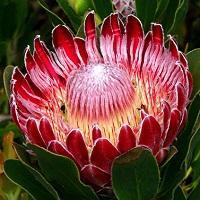
Although these vibrantly colored flowers produce a sweet, sugary nectar which one might expect to attract the attention of many birds, sugarbushes can only be pollinated by small rodents, namely by the Eastern Spiny Mouse.
This is because the nectar produced by sugarbushes contains a high amount of a sugar called xylose. Xylose cannot be properly digested by birds, who tend to avoid sugarbush nectar altogether. Instead, the sugarbush relies on spiny mice as a primary source of pollination, since the mice can digest the xylose that birds cannot.
Fun Fact: The process of pollination by mammals is called zoophily.

Behavior wise, Eastern Spiny Mice live in small communities of one or two males, several females, and their offspring. Spiny mouse communities are bound by kinship, which suggests that spiny mice have family recognition.
As far as reproduction goes, female spiny mice endure a gestation period of 38 to 45 days, nearly twice the length of that of mice and rats. Eastern Spiny Mouse litters are typically consisting of one to four pups, usually only two, and occasionally up to five.
Little is known about the evolutionary background of Eastern Spiny Mice, although they are believed to share a common ancestor with gerbils. Acomys dimidiatus now belongs to a family called Muridae, but it had formerly been classified along with Old and New World rats and mice.
Kingdom: Animalia
Phylum: Chordata
Class: Mammalia
Order: Rodentia
Family: Muridae
Genus: Acomys
Species: Dimidiatus
2 notes
·
View notes
Text
Blue-Tailed Day Gecko
Scientific Name: Phelsuma cepediana

A species of lizard native to Mauritius, one of the Mascarene islands, is an unusual pollinator helping to save several species of rare flowers from extinction. The blue-tailed day gecko is the key pollinator of critically endangered Roussea simplex and Trochetia flowers.

(Above: Blue-tailed day gecko feeding on the flower of a Roussea simplex)
The blue-tailed day gecko is a colorful green, blue, and red lizard that may be found in warm, moist habitats on the island of Mauritius, most usually near palm trees, banana, or papaya plants. They feed on small insects and the nectar of flowers. Despite reaching no longer than 6 inches in length, the geckos are tiny yet major pillars of the Mauritian ecosystem. Not only do they function in pollination but also seed dispersal in a wide variety of Mauritian plants.
Fun Fact: The blue-tailed day gecko is also the sole pollinator and seed disperser of the critically endangered plant Roussea simplex. The Trochetia flower, however, was previously pollinated by a critically endangered species of bird called the olive white-eye. Since the bird is now nearly extinct, the geckos on Mauritius have begun to take the birds’ place in saving the Trochetia flower from extinction.
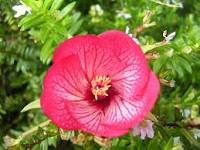
(Above: Trochetia flower)
Behavior wise, the blue-tailed day geckos are extremely aggressive both to each other and other lizards. In captivity, the male geckos are known to severely wound a female who is unable to escape, which means that the males and females must oftentimes be separated.
Female blue-tailed day geckos may lay several clutches of eggs in a breeding season, each clutch consisting of two eggs. The geckos are sexual reproducers who may breed any time between January and July. After a female lays her eggs in a safe location from predators, her eggs will hatch after a 47 to 82 day gestation. The young are self sufficient from the time they hatch and will survive on their own, catching small insects and becoming sexually mature themselves after one to two years.

Fun Fact: The blue-tailed day geckos have acute color perception. Some scientists theorize than several Mauritian flowers have developed colored nectars to utilize the lizards’ ability and attract attention to themselves.
The genus Phelsuma refers to all day geckos including the blue-tailed. The Mascarene Phelsuma are believed to have evolved from a common ancestor who rafted over to the Mascarene islands many years ago. Mascarene Phelsuma also share a common behavior, egg glueing; they glue their eggs to a surface, just as their ancient ancestor might have. This suggest that their ancestor that had rafted over to the Mascarene islands might have been native to rocky habitats.
Here is the taxonomy of Blue-tailed Day Geckos:
Kingdom: Animalia
Phylum: Chordata
Class: Reptilia
Order: Squamata
Family: Gekkonidae
Genus: Phelsuma
Species: Cepediana

2 notes
·
View notes
Text
Tasmanian Swift Parrot
Scientific Name: Lathamus discolor

This week focuses on the critically endangered Tasmanian Swift Parrot, a rare species of pollinator native to Australia that is doomed to go extinct in as little as 14 years, according to the Australian National University (ANU).
Despite its size, at 230-250 mm, these birds are key to the Tasmanian environment, being major pollinators of blue and black gum trees. The parrots are mostly green, with red and yellow patches around its beak, underwings and tail feathers, and blue feathers throughout its wings and tail. They feed mostly on the flowers of gum trees, gathering great amounts of pollen on their foreheads as they dip their heads into the flowers to eat. The picture below is a gum tree from Tasmania, which relies heavily on the endangered swift parrot for pollination.

Fun Fact: Swift parrots feed in small to large groups, which may be another reason as to why these birds are such effective pollinators; a large group of individuals is bound to transfer more pollen to a larger number of flowers.
Swift parrots are migratory birds that may be found on mainland Australia throughout the winter, but by August, they return to Tasmania to breed.
Upon returning to Tasmania, males and females split into mating pairs of two. After finding a safe spot to lay their eggs, the female parrot lays 4-5 small, white eggs. These may take up to 20-25 days to hatch, after which they are cared for by both parents until they are able to leave their nest.

Fun Fact: Swift parrot nesting sites can be found in the hollows of old trees, which may take hundreds of years to form. The same couple may not nest in the same site every year, so it is not uncommon for a hollow to be reused by a different mating pair every year.
Their breeding grounds are limited to eastern Tasmania within the range of gum trees, meaning that deforestation is critical to these birds whose habitat range is already extremely limited.

Fun Fact: The birds’ population is expected to halve every four years, ANU predicts.
Swift parrots appear to be social animals, not only feeding in groups but also migrating in flocks as large as 500. These flocks typically break into smaller flight groups of 10-20 individuals throughout the day.

Up until 2010, the swift parrot was thought to belong on the evolutionary tree of life, somewhere between lorikeets and broad-tailed parrots. This may be because of the swift parrot physical and behavioral resemblance to lorikeets. However, a study later proved the swift parrot belongs to a group called Platycercini along with many other Australian parrots.
Scientists suggest this may be a case of convergent evolution, or when two organisms evolve in different regions with similar traits due to a similar habitat and occupational niche. In other words, lorikeets and swift parrots are both found in similar habitats where they eat the same foods and have similar environments, so they evolved to have similar adaptations.
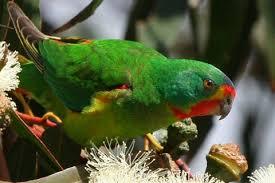
In this study, the closest living relatives of Tasmanian swift parrots were proved to be Horned parakeets, shining parrots, and Kakarikis. Their shared ancestor’s migratory habits are believed key to the divergence of these birds from all other Australian parrots.

Above is a picture of a pink flowering gum tree, which heavily relies on the swift parrot for pollination. Below is the taxonomy of Tasmanian swift parrots:
Kingdom: Animalia
Phylum: Chordata
Class: Aves
Order: Psittaciformes
Family: Psittacidae
Genus: Lathamus
Species: Discolor
2 notes
·
View notes
Text
Black and White Ruffled Lemur
Scientific Name: Varecia variegata

This week focuses on the world's largest pollinator, one of 33 extant species of lemur native to the remnants of the diminishing rainforest of Madagascar; the white-and-black ruffled lemur.
As its name suggests, the ruffled lemur is a small herbivorous primate between 20 and 22 inches and covered in black and white fur. This social primate lives in rival groups of 8-16 lemurs. Although insufficient research has been conducted regarding to social lives of lemurs, it is believed that the core of these groups are the females who protect the young and defend their territory from other groups.
The breeding season of Madagascar lemurs is between May and July. After a 102 day gestation period, most female litters will give birth to a litter of up to 6 babies. Before delivering her offspring she will construct a sturdy nest up in the safety of a tree 10 - 20 meters above the ground, keeping her babies safe from harm.
Fun Fact # 1: White and black ruffled lemurs are the only diurnal primates in the entire world that keep their young in a nest.
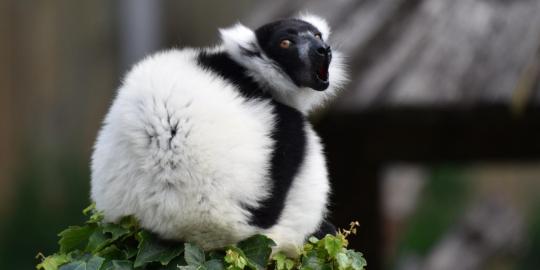
The baby lemurs cannot hold onto their mother; they must be carried snd transported in order to move. This causes a high infant mortality rate; an estimated 65% of baby white and black ruffled lemurs will survive to adulthood.
The black and white ruffled is primarily frugivorous, since 92% of its average diet is made of fruits, but it will also eat a variety of seeds, leaves, and, most importantly, nectar.
The world's largest pollinator has a unique ability to open flowers and lick their nectar with its long, specialized tongue. Pollen then clings to the lemur's snout and is transported to the next flower it feeds from. And seeing as this specimen reaches just under two feet tall, it may visit a large number of flowers in a day to feed itself. This makes it a vital component of Madagascar's unique ecosystem.
If you aren't familiar with the evolutionary history and significance of the Madagascar island, it is a small chunk of land off the coast of Africa which drifted away from the mainland following the separation of Gondwana (an ancient supercontinent made of all the southern landmass.) What makes Madagascar such a spectacle of study is that it is responsible for a large percentage of known primate species, including the lemur, which is only found on the island and no where on the mainland of Africa.
Fun (or not so fun) Fact # 2: The ruffled lemur, like all other lemurs, is endangered due to severe habitat loss caused by human settlement on the islands.

Researchers believe that the 50 species extinct and extant species of lemur share a common ancestor, a primate, which rafted to the island of Madagascar 40 - 50 million years ago. Although they have yet to trace the lemur's genes back to a single predecessor, they believe that when this ancient primate first arrived at the island, it branched across Madagascar and began to evolve to fill different niches on different parts of the island, creating the many different species of lemur we know today.
Below is the taxonomy of V. variegata
Kingdom: Animalia Phylum: Chordata Class: Mammalia Order: Primates Suborder: Strepsirrhini Family: Lemuridae Genus: Varecia Species: V. variegata
1 note
·
View note
Text
Honey Possum
Scientific Name: Tarsipes rostratus
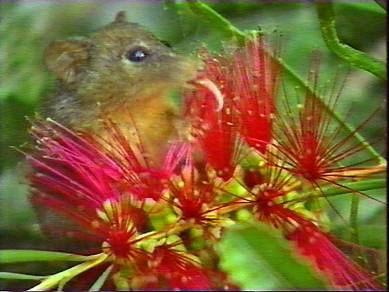
On the southernmost corner of Australia, a mouse sizes marsupial can be found known as the Tarsipes rostratus, or Honey Possum. The little brown and gray marsupial has lived alongside the indigeneous people for thousands of years and has developed many names, including honey possum and mouse.
It feeds itself by drinking the nectar from flowers with its specialized elongated snout. Despite its name, the honey possum is only vaguely related to possums and more closely related to possum like marsupials from Chile and South America.
Fun Fact #1: Ancestors of the early honey possum can be found as far away as Antartica.

DNA studies suggest that the Honey Possum evolved from a small possum-like marsupial from Chile in South America, and can even further be linked to microbiotheriid fossils discovered in South America, Antarctica and South Australia. Experts say that the honey possum's ancestors were stuck on the Austrailian continent after it drifted away from the large southern land mass named Gondwana, and since then has developed into the modern honey possum, or the noolbenger, as it is called by the land's indigenous people.
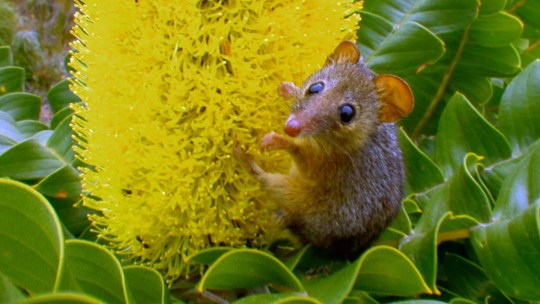
The honey possum may be found on coastal sand plains and heaths, where its diet consists mostly of the nectar from flowers. In a day, this mouse sized marsupial may drink twice of its body weight in nectar. This makes it a key component in south west Australia's ecosystem, which relies heavily on the little honey possum to carry pollen on its face from flower to flower.
Fun Fact #2: Although it is hardly a possum, Tarsipes rostratus has evolved to curl its tail around branches and hang vertically upside down.
The reproductive systems of Honey Possums are very unusual. Male honey possums, who are signifigantly smaller than their female counterparts, have large testes making up 4.2% of their body weight. Meanwhile, the female's eggs, which are otherwise standard for a mammal, may be fertilized by multiple males.
Here is the Taxonomy of Tarsipes rostratus:
Kingdom: Animalia Phylum: Chordata Class: Mammalia Order: Diprotodontia Family: Tarsipedidae Genus: Tarsipes Species: rostratus
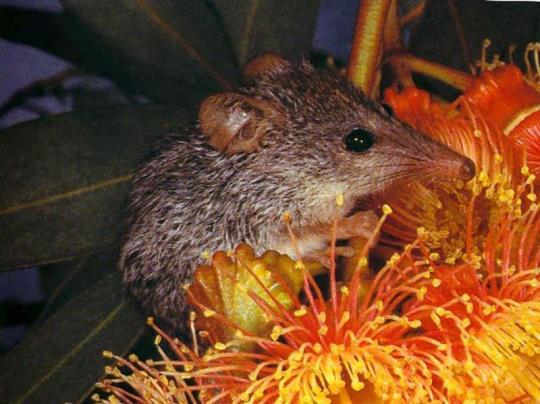
3 notes
·
View notes
Text
Cape Genet: A Mammalian Pollinator
Scientific Name: Genetta tigrina
When you think of pollinators, what comes to mind? Bees, hummingbirds, insects and small birds. You most likely do not imagine a large mammal, let alone, a mostly carnivorous one.

The South African cape genet is a species of genet alternatively known as a large-spotted genet. This small, catlike creature exercises a rare process known as zoophily, or the pollination of plants by mammals. It is distinguishable by its long body, light brown coat with large, open spots and a long, black tipped tail.
This species of genet is indigenous to areas of South Africa, found in densely wooded areas with high amounts of rainfall. Quite unexpectedly for an avid pollinator, the cape genet eats mostly meat. Its diet consists of mostly insects during summer months and birds and small rodents throughout winter. Less frequently, it is known to hunt some species of reptiles and amphibians.
On occasion, the caped genet is also known to eat seeds and fruits, but its diet is made mostly of meat. This is why it astonished researchers to find in a study that the caped genet makes frequent visits to sugarbush plants in order to drink their nectar. Researchers still do not know what attracts the genet to these plants, however, camera footage shows that when the genets stick their large heads into the flowers, their faces become covered in pollen which they then carry to the next plant.
Fun Fact #1: Much like a domestic house cat, the caped genet makes a variety of feline sounding noises, such as "meows," hissing, and spitting.

Little is known about the cape genet's behavioral patterns, although it seems to resemble most cats in this aspect. They are mostly solitary animals, expect for when mating or caring for young. They use their scent to communicate with other genets.
The caped genet is a sexual reproducer, however, little is known about its breed habits in the wild due to a lack of study. Researchers do know, however, that it breeds most in the warm, wet season, and that in captivity, genets display a very catlike manner of breeding.
Fun Fact #2: A female genet may bear a litter of 1-5 kittens after a 70-77 day gestation.

The evolutionary history of G. tigrina is a poorly investigated subject, however, a 2004 study offers some idea of its ancestral background. The study traces the earliest genet back to G. thierryi, from the subgenus Pseudogenetta. The second species to branch off was G. victoriae, the "sister species" of today's genets. G. tigrina, our caped or large spotted genet, appears to be the latest specimen of genet.
Click here for the entire study
Taxonomy of G. Tigrina
Kingdom: Animalia Phylum: Chordata Class: Mammalia Order: Carnivora Family:Viverridae Genus: Genetta Species: G. tigrina

3 notes
·
View notes
Text
Hummingbird Moth: Bird or Bug?
Scientific Name: Macroglossum stellatarum
Commonly known as clear wings or the hummingbird moth for its striking resemblance to the common hummingbird, Macroglossum stellatarum is an unusual species moth in the fact that it looks, moves, and behaves like the bird it is named for.
Sporting a plump and colorful body much larger than the average moth and long, transparent wings that appear almost invisible when they beat, the hummingbird moth is often mistaken for a small hummingbird. In fact, even its long proboscis, essentially its tongue, can be mistaken for the hummingbird’s slender beak.
Fun Fact #1: Clear wing moths fly and hover just like hummingbirds. Their fast beating wings even make a similar buzzing hum.
Clear wing or hummingbird moths can be found widespread across North America and many other parts world, however, it is native to Southern Europe and North Africa. The highly adaptable hummingbird moth may be found in a variety of habitats, but it prefers warm climates. Some moths will migrate south for the winter if their homeplace loses too much temperature in the cold season.
The clear wing moth is born from an egg as a little green caterpillar with a small horn on its tail. It hatches on the food plant which it was laid on as an egg and, like most moths, eats and grows until it is big enough to weave a cocoon and begin its metamorphosis into a moth. In the north, the caterpillar may remain its cocoon throughout the winter and emerge next spring. In the south, they may emerge more frequently from their cocoons.
Fun Fact #2: One of Macroglossum stellatarum’s most unusual characteristics is its breeding. Many moths might breed, lay its eggs, and fly away somewhere to die. The hummingbird moth, however, may lay up to four sets of eggs a year.
As an adult, the moths feed from flowers with large amounts of nectar. Similar to the way a hummingbird sticks its long beak into the flower to drink the nectar, the moths uncurl their long proboscis and suck the nectar from inside of the flower. Just like real hummingbirds, the moths are valued by gardeners as valuable pollinators.
But the question is, why do these moths not only look but behave and fly like real hummingbirds? Scientists say this may be a case of convergent evolution, or when two unrelated species evolve similar or identical characteristics. This most usually occurs when the two species occupy similar or identical niches, like hummingbirds and hummingbird moths, two pollinators with similar behaviors that evolved in different regions and happened to evolve similarly to each other.
Below is the Taxonomic Classification of hummingbird moths and hummingbirds.
Hummingbird Moth (Macroglossum stellatarum) Kingdom: Animalia Phylum: Arthropoda Class: Insecta Order: Lepidoptera Family: Sphinghidae Genus: Macroglossum Species: stellatarum
Hummingbird (Archilochus colubris) Kingdom: Animalia Phylum: Cordata Class: Aves Order: Apodiformes Family: Trochilidae Genus: Archilochus Species: colubris
These two species are distinctly unrelated, further suggesting convergent evolution as the reason behind their unusual similarity.



0 notes